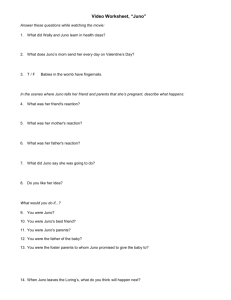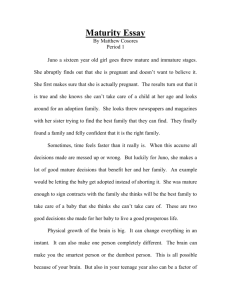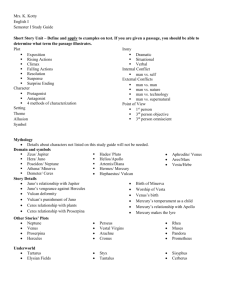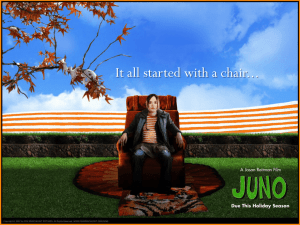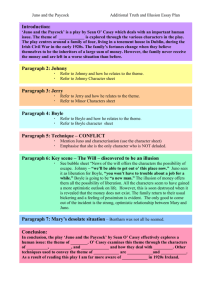Juno Ending Scene Analysis: Mise-en-Scène & Cinematography
advertisement
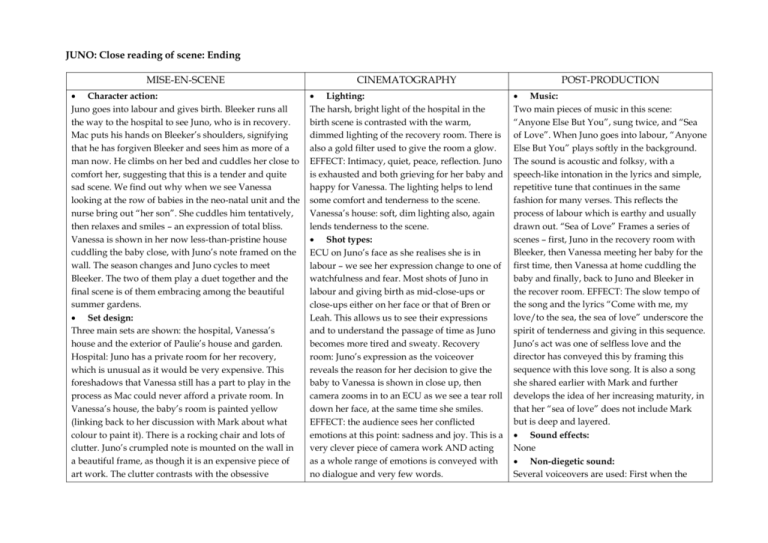
JUNO: Close reading of scene: Ending MISE-EN-SCENE CINEMATOGRAPHY POST-PRODUCTION Character action: Juno goes into labour and gives birth. Bleeker runs all the way to the hospital to see Juno, who is in recovery. Mac puts his hands on Bleeker’s shoulders, signifying that he has forgiven Bleeker and sees him as more of a man now. He climbs on her bed and cuddles her close to comfort her, suggesting that this is a tender and quite sad scene. We find out why when we see Vanessa looking at the row of babies in the neo-natal unit and the nurse bring out “her son”. She cuddles him tentatively, then relaxes and smiles – an expression of total bliss. Vanessa is shown in her now less-than-pristine house cuddling the baby close, with Juno’s note framed on the wall. The season changes and Juno cycles to meet Bleeker. The two of them play a duet together and the final scene is of them embracing among the beautiful summer gardens. Set design: Three main sets are shown: the hospital, Vanessa’s house and the exterior of Paulie’s house and garden. Hospital: Juno has a private room for her recovery, which is unusual as it would be very expensive. This foreshadows that Vanessa still has a part to play in the process as Mac could never afford a private room. In Vanessa’s house, the baby’s room is painted yellow (linking back to her discussion with Mark about what colour to paint it). There is a rocking chair and lots of clutter. Juno’s crumpled note is mounted on the wall in a beautiful frame, as though it is an expensive piece of art work. The clutter contrasts with the obsessive Lighting: The harsh, bright light of the hospital in the birth scene is contrasted with the warm, dimmed lighting of the recovery room. There is also a gold filter used to give the room a glow. EFFECT: Intimacy, quiet, peace, reflection. Juno is exhausted and both grieving for her baby and happy for Vanessa. The lighting helps to lend some comfort and tenderness to the scene. Vanessa’s house: soft, dim lighting also, again lends tenderness to the scene. Shot types: ECU on Juno’s face as she realises she is in labour – we see her expression change to one of watchfulness and fear. Most shots of Juno in labour and giving birth as mid-close-ups or close-ups either on her face or that of Bren or Leah. This allows us to see their expressions and to understand the passage of time as Juno becomes more tired and sweaty. Recovery room: Juno’s expression as the voiceover reveals the reason for her decision to give the baby to Vanessa is shown in close up, then camera zooms in to an ECU as we see a tear roll down her face, at the same time she smiles. EFFECT: the audience sees her conflicted emotions at this point: sadness and joy. This is a very clever piece of camera work AND acting as a whole range of emotions is conveyed with no dialogue and very few words. Music: Two main pieces of music in this scene: “Anyone Else But You”, sung twice, and “Sea of Love”. When Juno goes into labour, “Anyone Else But You” plays softly in the background. The sound is acoustic and folksy, with a speech-like intonation in the lyrics and simple, repetitive tune that continues in the same fashion for many verses. This reflects the process of labour which is earthy and usually drawn out. “Sea of Love” Frames a series of scenes – first, Juno in the recovery room with Bleeker, then Vanessa meeting her baby for the first time, then Vanessa at home cuddling the baby and finally, back to Juno and Bleeker in the recover room. EFFECT: The slow tempo of the song and the lyrics “Come with me, my love/to the sea, the sea of love” underscore the spirit of tenderness and giving in this sequence. Juno’s act was one of selfless love and the director has conveyed this by framing this sequence with this love song. It is also a song she shared earlier with Mark and further develops the idea of her increasing maturity, in that her “sea of love” does not include Mark but is deep and layered. Sound effects: None Non-diegetic sound: Several voiceovers are used: First when the tidiness of Vanessa’s house in previous scenes. The final scene, set outside Paulie’s house, serves as a backdrop for Juno and Paulie’s relationship and suggests that there is healing and re-birth happening, as the garden is resplendent, colourful and blooming. Properties: Juno’s note, the little car and the rocking chair. Juno’s note says “Vanessa – if you’re still in, I’m still in. Juno.” The parallel structure of this sentence seals the two of them together as though their fates are now entwined and inter-dependent. The little car is what she is rolling around on her belly when she goes into labour – just a charming little prop. The rocking chair gives circularity (“It ended with a chair”) as well as completing Juno’s metaphorical journey towards adulthood: it symbolised both the beginning of the pregnancy and the end of it. Costume: Juno’s costume at the end is her usual outfit of old jeans and comfortable shirts. This shows that she has grown a lot inside but the core of her personality is still the same – irreverent, sassy and unconventional. Vanessa’s track suit and old jumper contrast with her earlier spotless, classy outfits, showing the change she has also undergone. Dialogue: “Thundercats are go!” – Juno, when she goes into labour. This line is related to the fact that she has just been playing with a toy car. EFFECT: she is still a child and unaware of the ordeal of childbirth. It is also typical of Juno’s personality. “Doctors are sadists who like to play God and watch other people scream” – Bren. This is a comment any mother can relate to, aimed at the “mature” viewer. It also shows her concern and develops the idea of her Camera movement In final scene, the camera tracks Juno on her bicycle going to Bleeker’s house. EFFECT: it feels as though we are travelling with her and allowed to be observers of how their relationship has developed. Framing: The very final scene has Juno and Bleeker framed at the front of his house They sit on either side of the fence post, each with a guitar, and as the camera pans back it looks as though the scene is in perfect symmetry. The backdrop is revealed as a riotous bloom of colour. The symmetry of Juno and Bleeker with their guitars gives a feeling of balance and equality – a very “Zen” finish to the film where male and female are in perfect harmony. They even sing equal amounts of the song, finishing on the same note. baby is actually born. Then when she explains the decision she and Bleeker made: “He never felt like ours. He was always hers,” referring to Vanessa, while Juno is in recovery. The final voiceover is in the final scene, a monologue on her relationship with Paulie – “he is the cheese to my macaroni” and a piece of self-awareness that we as the audience can appreciate: “I know people are supposed to fall in love before they reproduce but I guess normalcy isn’t really our style.” This reinforces the fact that Juno is still Juno, despite the changes she has undergone and the maturity she has attained – she is still herself and her true character remains the same. Editing: As Juno’s labour intensifies, all dialogue is cut and the camera moves in slow motion. EFFECT: This slows down time and also focuses on the actual intensity of the process of giving birth – it is a long, painful and exhausting process (which is why it’s called “labour” – it’s hard work). At the beginning of the scene, there are fast camera cuts as the family leaves the house and gets into the car. This gives the feeling of slight panic, conveying the need to hurry. In Vanessa’s house, the camera shots dissolve one into the other, from the chair to Juno’s note to Vanessa holding the baby. EFFECT: There is a softness to the scene, reinforcing its tenderness. The fact that there are “no sudden moves” here also makes the audience subconsciously quieter, so as “not to wake the baby”. growing relationship with Juno when she is concerned for her and yells out for the “spinal tap”. “Someday you’ll be back here. On your terms.” – Mac. This foreshadows the fact that Juno doesn’t keep the baby as the viewer has no idea at this point what her decision has been. There is very little dialogue in this segment – it mainly consists of voiceovers, forcing the viewer to focus on the character action and to get clues about what is happening from their expressions and body language. This also helps to slow the pace down after the panic of the birth, suggesting a period of rest and recovery.

